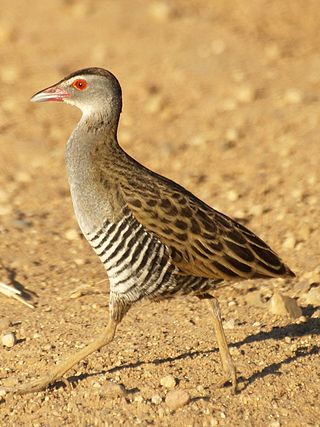
The watercock is a waterbird in the rail and crake family, Rallidae that is widely distributed across Southeast Asia. It is the only member of the genus Gallicrex.

The ruddy-breasted crake, or ruddy crake, is a waterbird in the rail and crake family Rallidae.

The Karnala Bird Sanctuary is located in Panvel Taluka of Raigad District, outside Mumbai, India near Matheran and Karjat.It is the first bird sanctuary in Maharashtra. The sanctuary is quite small with an area of 12.11 square kilometres but is, along with the Sanjay Gandhi National Park and Tungareshwar Wildlife Sanctuary, one of the few sanctuaries to be within reach of the city of Mumbai.

The African crake is a small- to medium-size ground-living bird in the rail family, found in most of central to southern Africa. It is seasonally common in most of its range other than the rainforests and areas that have low annual rainfall. This crake is a partial migrant, moving away from the equator as soon as the rains provide sufficient grass cover to allow it to breed elsewhere. There have been a few records of vagrant birds reaching Atlantic islands. This species nests in a wide variety of grassland types, and agricultural land with tall crops may also be used.

The red-necked crake is a waterbird in the rail and crake family, Rallidae.

The red-legged crake is a waterbird in the rail and crake family, Rallidae.

The tesias are a genus, Tesia, of Old World warbler. Though once included in the large family Sylviidae, more recent research placed it within a new family, Cettiidae. The four species inhabit undergrowth of montane forest in South and Southeast Asia, where they are resident or short-range migrants. They have longish legs and appear tailless, with (seemingly) only 8 rectrices. Their simple songs are fairly loud, and their nests are typically ball-shaped. Their name is derived from Tisi, the Nepalese name for the grey-bellied tesia.

The slaty-breasted wood rail is a species of bird in the subfamily Rallinae of the rail, crake, and coot family Rallidae. It is found in Argentina, Brazil, and Paraguay.

The white-throated crake is a species of bird in subfamily Rallinae of family Rallidae, the rails, gallinules, and coots. It is found in Colombia, Costa Rica, Ecuador, Honduras, Nicaragua, Panama, and Venezuela.

The Andaman crake is a bird species in the family Rallidae. It is endemic to the Andaman Islands of the eastern Indian Ocean.

Rallina is a genus of bird in the rail family, Rallidae. It contains four species found in forest and marshland in Asia and Australasia. They are 18–34 cm long and mainly chestnut or brown, often with black and white markings.












